Travel is supposed to be fun, and everyone has their interpretation of a joyful adventure. In the past decade, vehicle manufacturers have begun blurring the lines between performance, luxury, grand touring, and overlanding with a new crop of ultra overlanders.
Why test these extreme vehicles at all? The strongest impetus is the overwhelming popularity of the platforms and the increasing regularity with which they are being used for travel. We are seeing more of these models used for domestic and international overlanding, with several being highly appropriate, even in stock form. The second reason is as a testing ground for future technologies, as 4WDs like these often have a trickledown effect on future platforms. We are not suggesting that these are perfect long-term, around-the-world overland choices (except for maybe the GMC AEV), but I have never met a driver of these ultra overlanders who doesn’t seem to have a permanent grin.
From the start, these ultras have two significant limitations, starting with the payload for the pickups. They all have less payload than a Ford Maverick or a Toyota Camry, which can be an issue when considering campers or even towing trailers (tongue weight is part of the payload). It is undoubtedly a shift in expectation, as we typically view a pickup as a tool for hauling everything from lumber to motorcycles. On the TRX, for example, you couldn’t even carry two dual-sport motos and their riders with gear. The one saving grace is that all trucks are extremely robust, with significant reserve capacity built into the axle strength, bearings, suspension, and frame. Vehicles perform best at 80 percent of GVWR or less, translating to a driver, passenger, and a few backpacks with camping gear. The second limitation is the fuel range for everything but the GMC with diesel. These vehicles are so lively to drive that most of our testing mpg was in the low teens or even single digits. Only the GMC has the provision (with EPA restrictions) for a larger fuel tank. In the cons for each model, we do not mention purchase price, mpg, or payload, as these are limitations for nearly every contender.

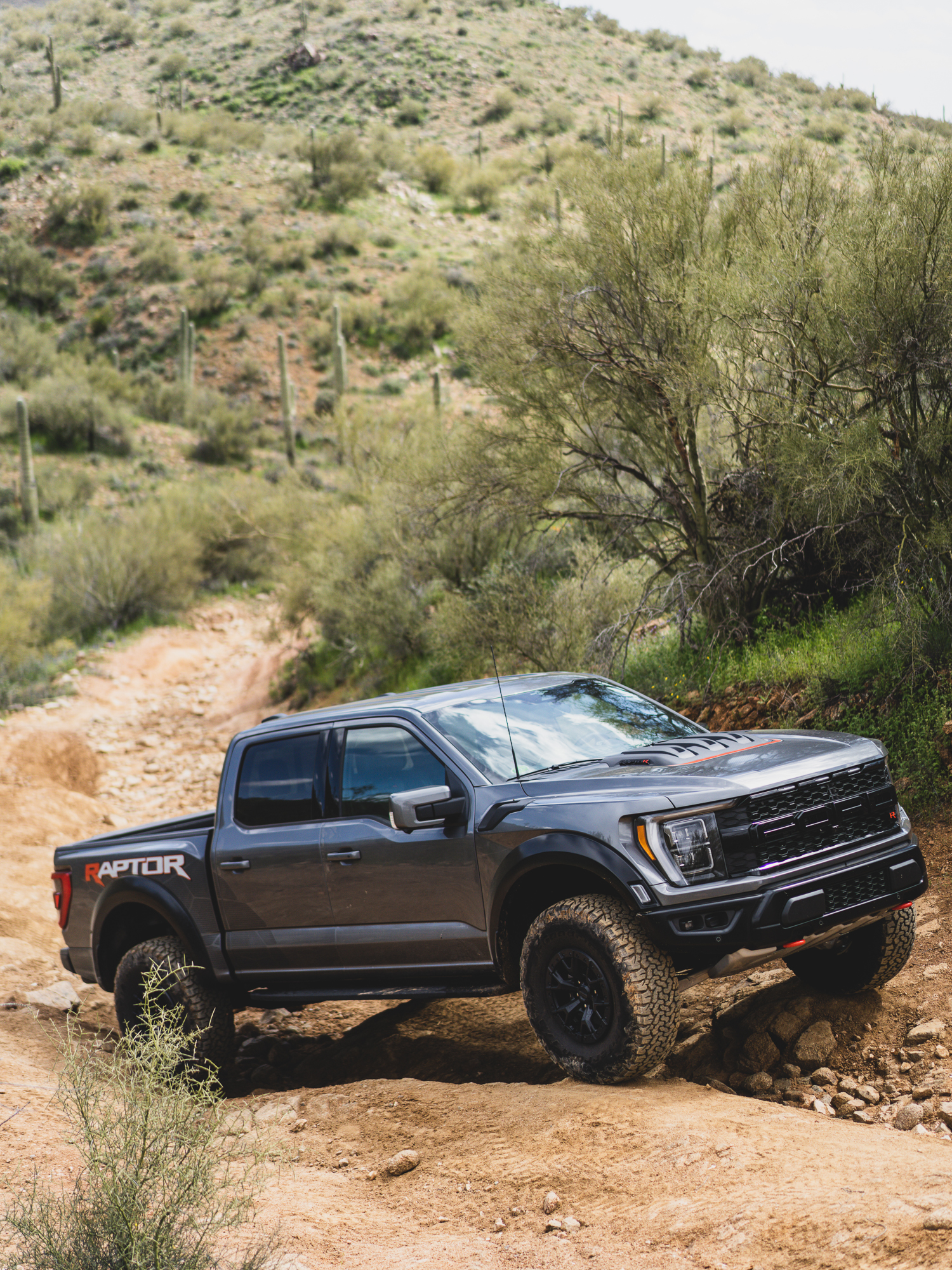


With the cons and caveats out, let’s dig into the upsides. Principally, each of these vehicles is an extreme performer, which makes them capable and impressively safe to operate. If the driver keeps to reasonable speeds, the limit handling, accident avoidance, and impact protection are world-class. If weight is kept down and driving behaviors are reasonable, few overland platforms can match the ease with which these models traverse classic overland routes. Ultra overlanders result in endless conversations with other travelers and the general public about the thrills of ownership. Another often overlooked benefit is that these models are ready for the dirt right out of the box, with little to no modification and a full factory warranty.
Our testing of these units spanned close to two years in various terrains and conditions. We took each one through our traditional test loop and sought unique challenges to test their limits. We added a load that simulated a typical camping kit (keeping the curb weight to 80 percent of GVWR or less) and even towed trailers behind the pickups. While we were more pedantic in our evaluation than necessary, we acknowledge that the conclusions are equal parts objective and subjective. The test is admittedly apples and oranges in many ways, with the one common denominator of smiles per gallon.
Ford Bronco Raptor | A wildly capable thoroughbred

In the early 1960s, Donald Frey was on a mission to revamp the Ford lineup with exciting new models and was the impetus behind the Mustang and the Bronco. Curiously, it was Lee Iacocca who put the final approval to the Bronco, bringing it to reality with the 1965 production year. The original model was specifically designed to compete with the Jeep CJ-5 and International Harvester Scout by providing better ride quality and a more comfortable (and quiet) interior, all while retaining off-road performance. This timeframe was also the beginning of the Bronco’s success in desert racing, with five Baja 1000 class wins between 1967 and 1972; this continued with the new Bronco R race prototype, which Ford raced in the 2020 Baja 1000. For 2023, Ford released the Bronco Raptor, set to create a legacy all its own.
On the trail, driving the Bronco Raptor is an effortless affair, with the 37-inch BFGoodrich All-terrains, front and rear lockers, and the front sway bar disconnect all working in concert to overcome most obstacles it will fit between. We say fit, as the Bronco is wider than the GMC AT4x full-size in this test at 85.7 inches without the mirrors. The sway bar disconnect is the feature that most impressed me; it can be released even with a cross-axle load, significantly improving articulation and occupant comfort. The wide track provides a lot of driver confidence at any speed, but watching the fender flares around any trees is essential. For a stock vehicle, few compare with the Bronco in technical terrain, and the IFS never proved to be a limiting factor on any obstacle. The crawl ratio is an optimal 67:1, which provides sufficient reduction yet still cruises easily between obstacles. Ground clearance is an impressive 13.1 inches (even with a Dana 50 rear axle), and breakover tops are 30 degrees. The only limitation on the trail is the width of the fenders, which are hideous enough that I wouldn’t shed a tear if they got lopped off.
As an overland vehicle, the Bronco has a few advantages, starting with the ride quality. The Bronco is easy to drive and has limited head toss once the sway bar is disconnected. It is right-sized as a wagon, with a long enough wheelbase to provide stability, yet compact enough for more technical forays. The interior volume is practically identical to the Wrangler at 103.7 cubic feet, but the payload on our test unit came in at just over 1,000 pounds, and the curb weight tips the scales at 5,764 pounds, within 10 pounds of a standard F-150 Raptor. While we didn’t remove the Bronco’s top, it has the advantage of top- and doors-off driving.
Overall, the Bronco is surprisingly easy to drive daily, with only the monster width causing awkward parking and trail moments. It is responsive, with the familiarity of a wagon configuration. The motor fell short of expectations, particularly when the fuel economy barely averaged double digits. We clocked 0-60 in just over six seconds and averaged 10.8 mpg for our testing tank. The Ford Bronco is one of my favorite platforms, as I like the retro styling and near-perfect balance of capability and driveability. The Bronco turns everything up to 11, with only those afterthought fender flares taking the wind out of its ultra sails.
$90,000 | ford.com
Pros
- Extreme trail and high-speed performance
- 37-inch tires on 17-inch wheels
- 13.1 inches of ground clearance
Cons
- Slower than horsepower numbers indicate
- Fender styling incongruent with classic lines (and way too wide)
Ford F-150 Raptor Type R Editor’s Choice | The fastest way from point A to Z

Arguably, the ultra overlander category started with the Raptor, a model launched in 2010 by the Ford SVT division. The concept was to bring trophy truck looks and performance to the consumer segment, featuring the most powerful engine available, paired with a wider track, mid-travel suspension, and the fitment of much larger tires. The Raptor was a runaway sales success and created a halo model for the world’s best-selling pickup.
On the trail, the F-150 was the surprise of the test, far exceeding my expectations and outperforming the other full-size models with aplomb. It feels lighter and surprisingly nimble, although one can never underestimate the 87-inch width (without the mirrors) and 50-foot turning circle. After testing the F-150 across all of our test tracks, it was clear that a few features make an outsized difference, starting with the 37-inch tires on 17-inch wheels. With this combination, Ford exceeds our standards for tire configuration performance, with the tire diameter more than double the wheel diameter. This results in excellent flotation in soft conditions like sand and snow and 13.1 inches of ground clearance. In addition to all the clearance under the axle, the Raptor has excellent trail clearance overall and sits up several inches higher than the other full-size units. The only limitation we encountered on the test loops was the aluminum rock rails’ width, which proved surprisingly durable despite contact with several rocks and ledges. Curiously, the new Raptor drops the Torsen-style front limited slip in favor of more aggressive traction control modes and one-pedal drive.
For overlanding, the Raptor R was the surprise of the test, with a 1,520-pound payload (on the door sticker) and a usable 8,700-pound towing capacity. We hitched a Patriot Camper behind the F-150 for the tow test and took off for several days of exploring Central Arizona. Few trailers on the market can survive behind a Raptor, but the X3 has a long-travel independent suspension and robust construction, a perfect complement to the Ford. We towed the trailer through desert washouts, deep sand, and steep climbs as we made our way to Alamo Lake. The cabin is quiet and comfortable, with supportive seats and good ergonomics. The other impressive feature is the 36-gallon fuel tank, which provides the test’s best unleaded fuel range at 432 miles (highway).
The Raptor held many surprises and felt the most serious as a performance overlander, combining reasonable payload with a laundry list of impressive hardware. The ride quality favors larger events and serious closed-course speeds on the dirt. It was similar in performance to full SCORE race trucks I have piloted, yet it can be driven daily. That seriousness means less luxury and a firmer ride at low speeds and around town, but it is a pleasure to drive. The 700 horsepower is usable in most conditions, though any attempt at Baja mode in 2WD is inviting disaster; put it in 4WD on the dirt to save the tires and your ego. The Raptor R has a shocking breadth of capability, yet you can still fit a Go Fast Camper, load it up with camping gear, and drive the Americas. I remember the first overland vehicle we encountered upon arriving in Ushuaia, Argentina—a Raptor with Montana plates.
$109,000 | ford.com
Pros
- 37-inch tires on 17-inch wheels
- 13.1 inches of ground clearance
Cons
- Lacks super truck interior
- Width limited on some trails
- Suspension only shines at speed
GMC Sierra 1500 AT4x AEV Value Award | Diesel double-locked dream truck
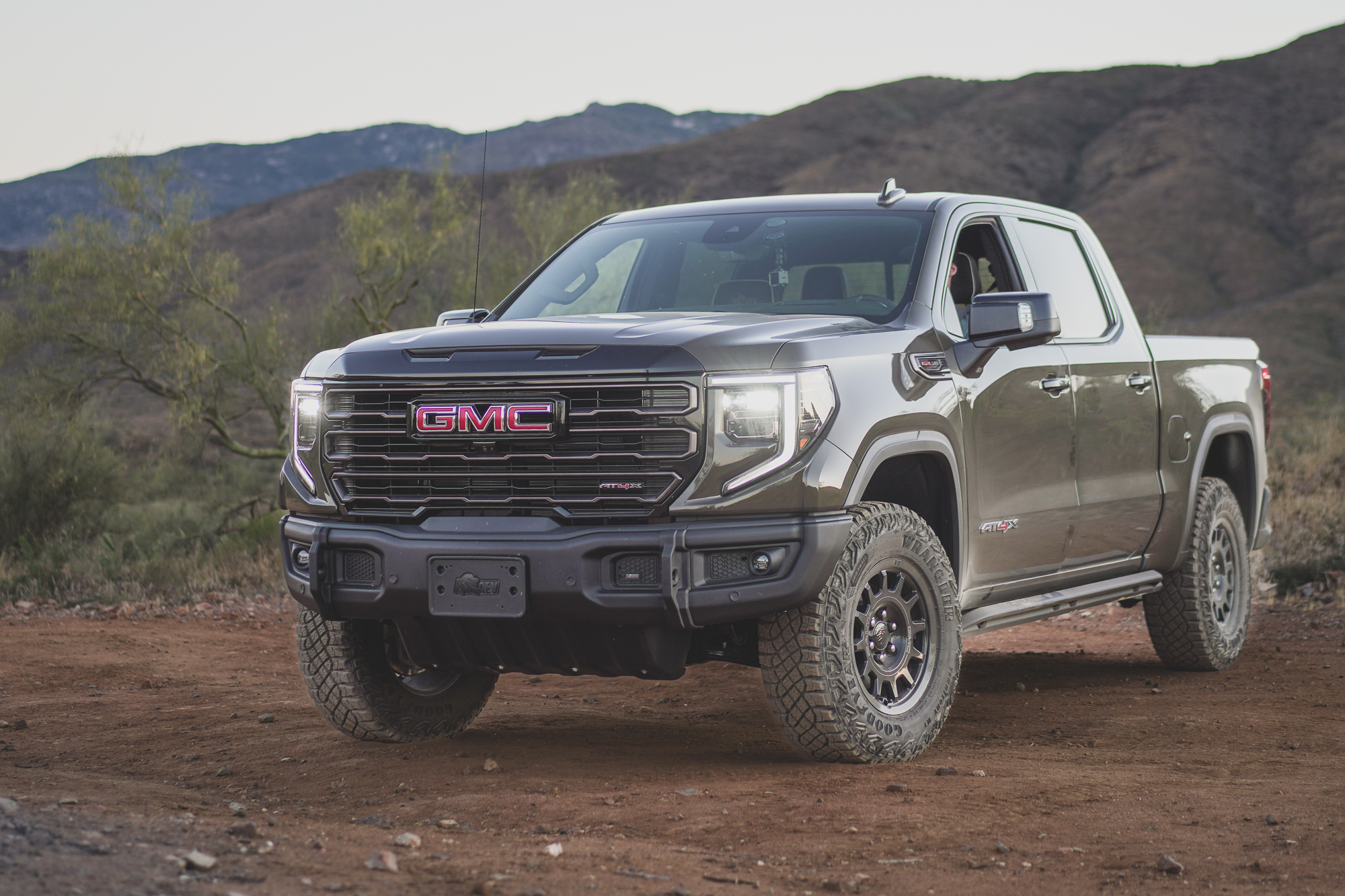
Starting in 1911, GMC began as the General Motors Truck Company, and for the next 112 years, they have focused on trucks and SUVs. From its inception until 2019, the focus had been on commercial and governmental buyers. In the 2020 model year, the company fully embraced its steady progress toward being the world’s only luxury truck brand. This strategy started in 1998 with the first Denali and, most recently, eclipsed six figures with the Yukon and Hummer nameplates. But for our interests, the launch of the 2019 AT4 model was the most compelling. The AT4 lineup exploded in popularity and soon became the most popular package for the brand, even gracing their SUVs and crossovers. The recent advancement of off-highway capability within GM is entirely owed to overland enthusiasts within the engineering, product planning, and marketing ranks. Great overland vehicles come from companies enabling employees to explore new models and possibilities.
The AT4 was a significant leap forward. However, the AT4x and, ultimately, the AEV editions, vaulted GMC and Chevrolet to the front of the 1/2-ton pack, combining low-speed technical-terrain capability, daily driver efficiency (diesel), and higher-speed suspension performance. For 2024, the 3.0-liter Duramax turbo-diesel returns, mated to a 10-speed automatic, which boasts 305 horsepower and nearly 500 pound-feet of torque. With the small displacement and active thermal management, the engine is also optimal for fuel economy and overland range, allowing for almost 500 miles on a single tank. The diesel also has aftermarket tanks to push that range to 700+ miles. We have a similar motor in our 2022 GMC AT4, and it has been my favorite drivetrain in any North American spec vehicle I have owned.
The engine drives a part-time transfer case with low range and front/rear driver-selectable locking differentials. Traction is aided by a terrain mode that ensures maximum traction control intervention at low speeds. This is important for scenarios where a front locker engagement is not optimal (tight turns and slippery surfaces). The independent front suspension is 2 inches taller than the base Sierra, and the tires are 33 inches, providing an 11.1-inch minimum ground clearance and improved approach/breakover/departure angles of 34/22.6/24.4 degrees, respectively. Additional trail performance comes from the steel front and rear AEV bumpers, aluminum rock rails, and boron steel skidplates. The dampers are premium Multimatic DSSV units front and rear, a suspension we have continuously ranked as one of the most effective for overland conditions.
The strengths of the AT4x AEV are in the broad scope of capability, providing daily driver useability and a standard track width for technical terrain. It is comfortable on long road trips yet still has performance reserves for higher speeds in the deserts. The Sierra 1500 AEV is also the only diesel-available platform in the ultra-overlander segment, giving the rare attribute of efficiency. Our primary concern with the model is the payload of 1,000 pounds for a five-passenger, full-size truck.
$86,090 | gmc.com
Pros
- AEV quality, engineering, and durability
- Class-leading warranty
- Optimal balance of capability, comfort, and utility
Cons
- V8 provides uninspiring performance and economy (but the diesel is a dream)
- 1,020-pound payload falls short of minimum standards
- Needs 35-inch tires to realize full potential as an ultra overlander
Jeep Wrangler Rubicon 392 | The 392 is peak Jeep—prove us wrong
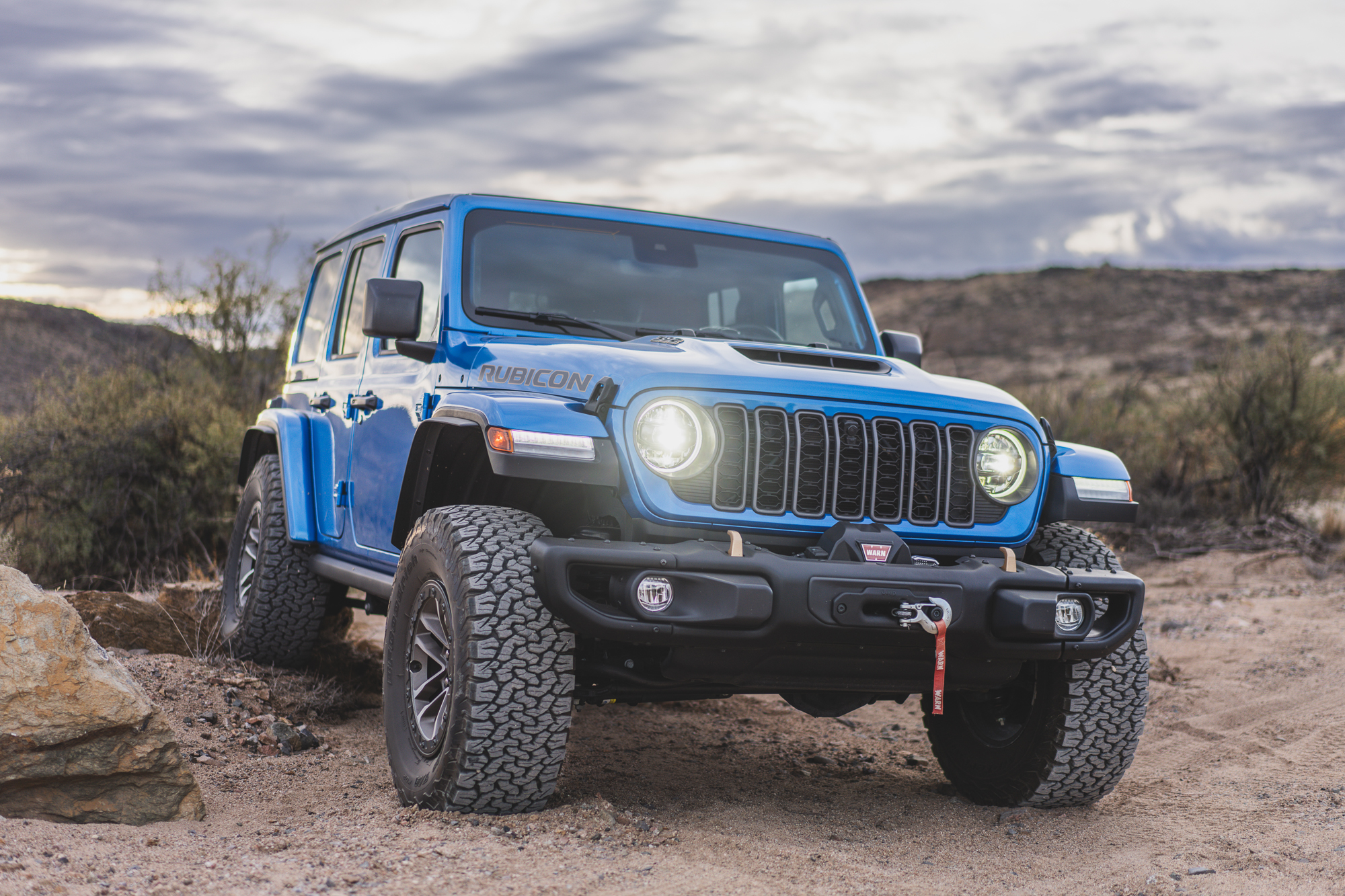
Heritage has its privileges, and no other model in this lineup has more legacy and earned credibility than the Jeep. And while the company was admittedly asleep at the wheel from about 1980 to 2003, Jeep has had hit after hit, from the first Rubicon in 2003 to the JK variants to the extreme Jeep 392 in this test. Jeeps in 2024 are supremely capable, adequately comfortable, and more overland-ready than ever. You can get the newest Wrangler in some models with a full-floating rear axle and payload that exceeds 1,400 pounds.
Let’s cut right to the chase and acknowledge that the 392 is absolutely mental and about as fun as taking a rocket to the International Space Station for lunch and a few zero-gravity selfies. My inner 17-year-old took over completely, and it took me almost three hours before I stopped giggling uncontrollably while smashing the throttle (with the exhaust on full petulant mode). Certainly, there are other models in this comparison that have similar acceleration, but I think it is the fact that Jeeps are not “supposed” to be this fast, riding on 35-inch tires, with solid axles, steel bumpers, a Warn winch, and a power convertible top. It all works together to provide a range of performances once unimaginable, where you could blow the doors off a 911 on Friday and drive the Rubicon effortlessly on Saturday.
Admittedly, all is not rainbows and hydrocarbons, although it seems petty to call any of them a legitimate limitation. The standout difference with anything in this test is the medium- to high-speed performance on the dirt, as everything else in the lineup is superior (by quite a margin). The motor will start writing checks on the dirt that the chassis has no prayer of cashing. I even uttered a “Whoa, Nelly!” at one point, which is undoubtedly a first in my testing career and would have made any of my driving mentors blush. The only real disappointment is that the 392 didn’t get the new 5,000-pound tow rating, which would have helped offset the dismal payload of 960 pounds. I suspect 392 owners will have plenty of boats to tow and a cool overland travel trailer to use as a base camp.
Traveling out of the 392 is similar to most other Wranglers, where the advantage is to pack light and keep the weight low. Don’t even consider a roof rack, which will further punish the fuel economy and shift the center of gravity (COG) higher. I used a few aluminum storage boxes and most of my motorcycle camping kit. A small fridge (an Engel, in my case) fits just fine in the back and plugs into the factory 12-volt outlet. The 392 was one of the most fun vehicles I have ever tested, a magic carpet ride with an exuberant V8 symphony. If you can own one, do it because the sun is setting on peak Jeep’s moment in the light.
$102,000 | jeep.com
Pros
- Best technical terrain performance in the test
- Sounds and feels gloriously quick
- Convertible power top
Cons
- Requires caution at speed due to limited compression travel and high COG
- Missing the 5,000-pound tow rating of the full-floating axle upgrade
- My inner 17-year-old is still bitter that I didn’t buy one
Ram TRX | Ultra luxury and performance in a pickup
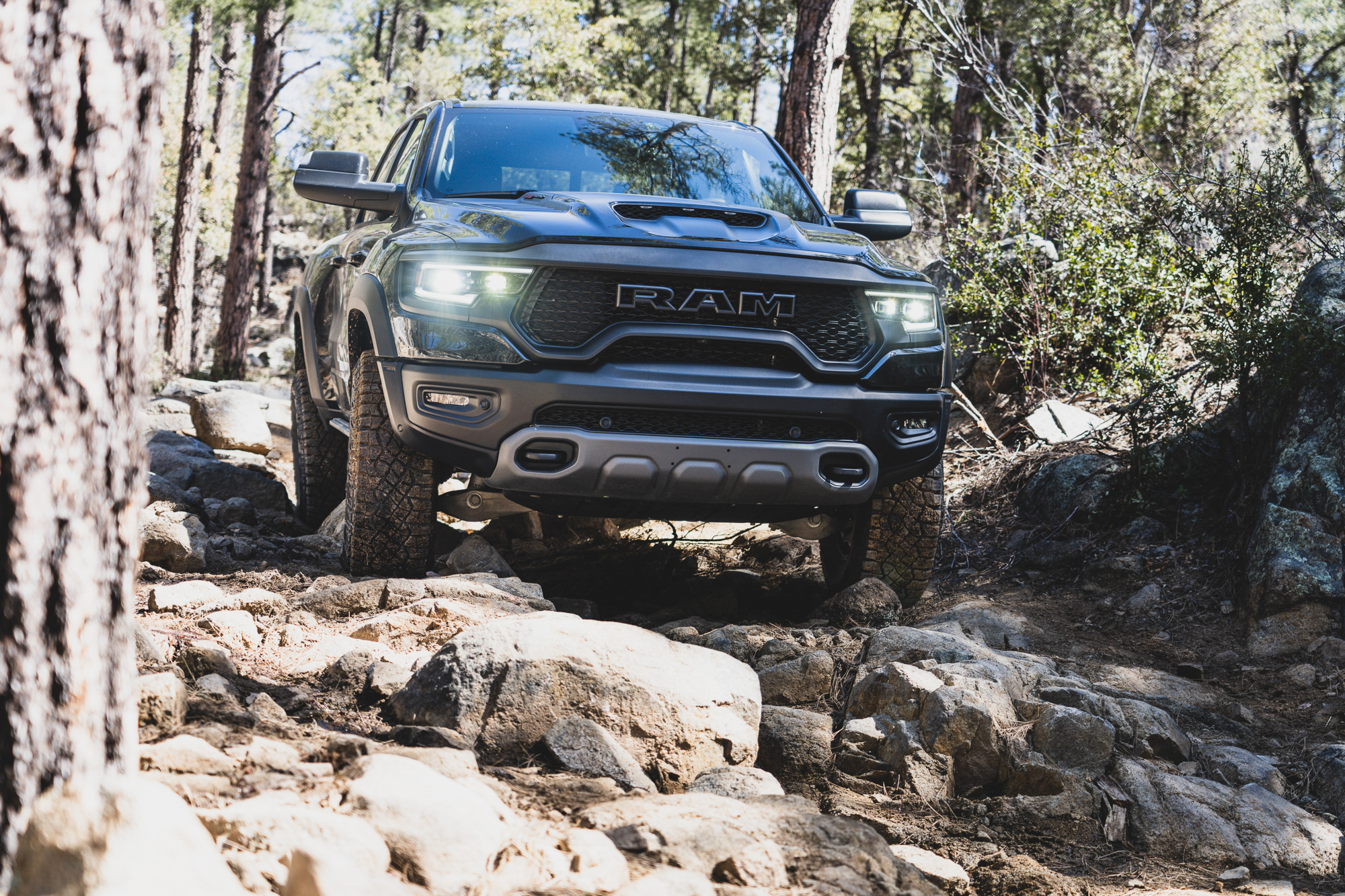
In 2016, the Raptor gained considerable media and consumer attention, but Ram did not intend to be outclassed. I was in Moab testing new Jeep models when Ram’s engineering and product development team invited me to preview something “interesting.” I stood in anticipation as a V8 roared to life around the bend of a desert two-track and vaulted around the corner, a deep red, full-size, half-ton barking through the whoops, its stance as wide as the trail, sand flying, the 35-inch tires dancing across the terrain. It was the concept TRX, and it exceeded all my expectations. It was yet to be named, and the factory specifications would only improve when this apex predator was announced in August 2020.
It was the TRX that inspired Matt Scott to coin the term Grand Tour Overlander, based on his time owning a brilliant blue 2021 model, which he flogged with abandon across the desert Southwest and ran chase for the Rebelle Rally. Matt has owned a lot of stunning Grand Touring automobiles and dozens of overland 4WDs, so his endorsement of the TRX as his best touring vehicle carried considerable weight. His lauding of the model is justified, as the specifications read like a hypercar with a supercharged V8 producing 702 horsepower and 650 pound-feet of torque. All this power is usable given the wheelbase and track width, providing the stability, suspension travel, and traction necessary to make it all work with a degree of predictability. The frame is constructed from 95 percent high-strength steel with further reinforcement over the stock Ram. Stability comes from the 6-inch wider track width and Bilstein Blackhawk e2 shocks with remote reservoirs. Suspension travel is 13 inches in the front and 14 inches in the rear. The spring rates are soft, and the rear is progressive, yielding a supple and composed smooth ride quality on all surfaces but also limiting some of the platform’s large event (impact) capabilities, although I do not see that as a con.
The TRX is seriously wide for the trail at 88 inches without the mirrors, which will result in constant brush scratches. Despite the width, it is thoroughly enjoyable to drive, and I often neglected to air down because the ride quality is superior to anything we have tested. Once aired down, it becomes a true magic carpet, floating along with the ease of a Herman Miller on wheels. For traction, the 35-inch tires are available on optional beadlock wheels, and the rear differential can be locked at the driver’s discretion. Traction control is also effective with multi-mode to accommodate low-speed technical terrain, sand, and desert racing conditions. The TRX is stable and compliant at higher speeds, further aided by the AWD. The interior feels premium, like the GMC, with supportive seats and thoughtful touchpoint materials. I would comment on the Harman Kardon stereo, except that I spent most of the test with the windows open, listening to the whir of the supercharger unleashing 702 horsepower through the dual exhaust.
$96,000 | ramtrucks.com
Pros
- 702 horsepower supercharged Hellcat V8
- Premium ride quality
- Most luxurious and comfortable interior of the test
Cons
- Skipped leg day with the 35s
- Lacks tuning or jounce control for more significant impacts
Noteworthy Alternatives
2023 Mercedes-AMG G63 4×4²
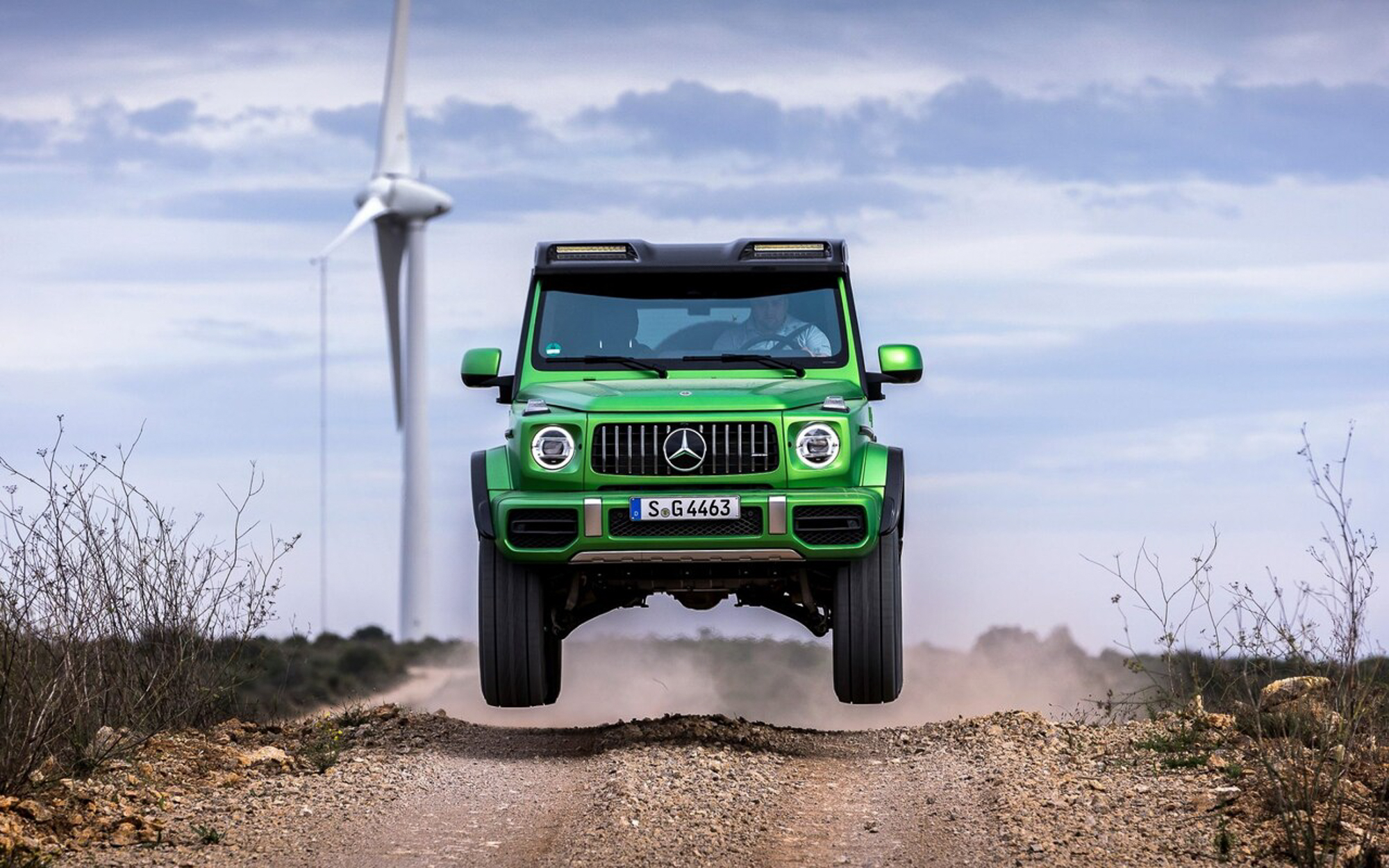
As the definitive and unobtanium ultra overlander, the G63 4×4² continued with the 2022 model, complete with portal axles; 35-inch tires; three differential locks; and a hand-built, 4.0-liter, twin-turbo V8 producing a head bolt shearing 577 horsepower and 612 pound-feet of torque. Its ultraness continues with the interior and custom exterior paints (at the owner’s discretion). Despite the luxury appointments, there is still a G-Wagon underneath, with nearly 18 inches of ground clearance and a breakover angle of 42 degrees (both are better than anything else in this test). Ultra indeed.
Tundra TRD Pro

Toyota tends to shy away from the ends of the bell curve and has rarely produced vehicles that qualify as extreme by any measure. However, they are starting to push the envelope with higher horsepower, improved Fox suspension, rear lockers, and larger tires. The hybrid drivetrain produces 437 horsepower and 583 pound-feet of torque. While it unfortunately lacks any PHEV range, it does improve mpg slightly, along with 0-60 in six seconds. In our testing, the 2022/2023 TRD Pro Tundra is a significant improvement over the outgoing 2021 Gen-2 Tundra and is one of the better-performing half-ton offerings. Payload is still diminutive in Pro form, but towing can be specified over 11,000 pounds.
Ram Power Wagon

Even 10 years ago, an ultra-overlander article would have only included two models, the Raptor and the Power Wagon. So much has changed since, and the Ram “Rubicon” is still no less impressive. The Power Wagon has survived numerous sunset attempts by product planners, yet it sells well due to the long list of capabilities. Compared to many others in this test, this is an anvil with a factory Warn winch, sway bar disconnect, front and rear solid axles with lockers, steel skid plates, and even beadlock-capable wheels. It lacks a diesel and 35-inch+ tires, but few trucks are as honest in their pursuit as the timeless Power Wagon.
Conclusions
From the start of this test, the goal was not to take the evaluation, or ourselves, too seriously. Any vehicle in this category is a purely visceral and emotional purchase. To justify functionality is a laughable and easily deconstructed argument. Hence, the specs, pros and cons, etc., are only here as a guide, helping to keep this endeavor from going entirely off the rails. In the same breath, I was genuinely impressed by how many of these models worked for backcountry travel, primarily because of the melding of capability and comfort. A road trip in any of these vehicles is a splendid affair, as are most backcountry routes in North America.
The Bronco Raptor had a near-impossible breadth of capability, almost matching the 392 in the rocks and leaving the Jeep in the dust at moderate to higher speeds. But the Bronco falls short of what I would want an ultra overlander to be; the flares are an afterthought, and the engine is uninspiring. I am a fan of the Bronco—just not this one. The Jeep, however, connected in ways I didn’t expect. My first memory of a 4WD was my grandfather’s Jeep, and the 392 is peak Jeep. It is fast, loud, and capable, and the chorus from the Hemi resonated with every childhood daydream. Unfortunately, compared to the others in this test, handling fell short once the speeds exceeded a low-range pace. The Jeep is the ultra overlander you date, but don’t take on the long journey.
For the Editor’s Choice, the decision was a greater struggle than expected, mostly because I had such a ridiculously good time with each of these vehicles. The decision came down to the comfort of the TRX, the capability of the Raptor R, and the does-it-all AT4x AEV. In my experience, the TRX is the most enjoyable for the average owner, as it is mind-numbingly powerful yet well-tuned for safety and control. It falls short at the limits, although most buyers would never flirt with that end of the bell curve. The TRX feels premium, even luxurious—but the TRX is ending as a model, and it shows how far the other manufacturers have come in response to the gavel it dropped.
The GMC AT4x AEV is an incredible truck, possessing the broadest range of capability and utility in the test, complete with a full range of AEV accessories, a standard track width (a bonus in my mind), the fantastic Multimatic suspension, dual lockers, and a powerful yet efficient small-displacement diesel. The GMC is the vehicle in this test I would buy, but it falls short of the Raptor in every performance category. If the GMC had 35-inch tires and 30 percent more payload, it would have nabbed the crown. As a result, the Ford Raptor R wins our Ultra Overlander Editor’s Choice because it captures nearly everything we would want a wild and untamed 4WD travel vehicle to be. From 700 horsepower to 37-inch tires and Fox long-travel suspension, it all works in concert to be violently fast on a closed course. All of that capability also makes it surprisingly useful for every other trail and travel condition, easily overcoming technical obstacles with the class-leading tire size and 13.1 inches of ground clearance. It traversed obstacles that the GMC and Ram struggled to climb without dragging.
We typically have a Value Award for Main Gear Reviews, yet that doesn’t seem easy to justify with a median MSRP exceeding $90,000. Even so, the argument can easily be made that the GMC AT4x is the best overall value in this test, combining the class-leading and efficient turbo-diesel with a full complement of AEV hard parts. The base price still seems steep, but a quick tally of the modifications required to bring a standard Sierra to this spec shows the value. The GMC is also the truck I want to own in this lineup and is the most appropriate for long-distance international travel (assuming ULSD availability). Overall, this test has been a literal blast, and I have a whole new appreciation for these ultra overlanders. Thank you for coming along for the joy ride.
Listen to Episode 185 of the Overland Journal Podcast: Ultra Overlanders
Editor’s Note: This article was originally published in Overland Journal’s Spring 2024 Issue.
Our No Compromise Clause: We do not accept advertorial content or allow advertising to influence our coverage, and our contributors are guaranteed editorial independence. Overland International may earn a small commission from affiliate links included in this article. We appreciate your support.


